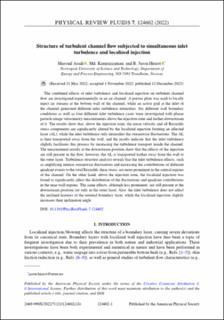| dc.contributor.author | Asadi, Masoud | |
| dc.contributor.author | Kamruzzaman, Md | |
| dc.contributor.author | Hearst, Robert Jason | |
| dc.date.accessioned | 2023-02-15T07:23:02Z | |
| dc.date.available | 2023-02-15T07:23:02Z | |
| dc.date.created | 2022-12-13T08:45:21Z | |
| dc.date.issued | 2022 | |
| dc.identifier.issn | 2469-990X | |
| dc.identifier.uri | https://hdl.handle.net/11250/3050884 | |
| dc.description.abstract | The combined effects of inlet turbulence and localized injection on turbulent channel flow are investigated experimentally in an air channel. A porous plate was used to locally inject air streams at the bottom wall of the channel, while an active grid at the inlet of the channel generated different inlet turbulence intensities. Six different wall boundary conditions as well as four different inlet turbulence cases were investigated with planar particle image velocimetry measurements above the injection zone and farther downstream of it. The results show that, above the injection zone, the mean velocity and all Reynolds stress components are significantly altered by the localized injection forming an affected layer (AL), while the inlet turbulence only intensifies the streamwise fluctuations. The AL is then transported away from the wall, and the results indicate that the inlet turbulence slightly facilitates this process by increasing the turbulence transport inside the channel. The measurement results at the downstream position show that the effects of the injection are still present in the flow; however, the AL is transported farther away from the wall to the outer layer. Turbulence structure analysis reveals that the inlet turbulence effects, such as amplifying intense streamwise fluctuations and increasing the contributions of different quadrant events to the total Reynolds shear stress, are more prominent in the central regions of the channel. On the other hand, above the injection zone, the localized injection was found to significantly affect the distribution of the fluctuations and quadrant contributions in the near-wall regions. The same effects, although less prominent, are still present at the downstream position yet only in the outer layer. Also, the inlet turbulence does not affect the inclined features of the internal boundary layer, while the localized injection slightly increases their inclination angle. | en_US |
| dc.description.abstract | Structure of turbulent channel flow subjected to simultaneous inlet turbulence and localized injection | en_US |
| dc.language.iso | eng | en_US |
| dc.rights | Navngivelse 4.0 Internasjonal | * |
| dc.rights.uri | http://creativecommons.org/licenses/by/4.0/deed.no | * |
| dc.title | Structure of turbulent channel flow subjected to simultaneous inlet turbulence and localized injection | en_US |
| dc.title.alternative | Structure of turbulent channel flow subjected to simultaneous inlet turbulence and localized injection | en_US |
| dc.type | Journal article | en_US |
| dc.type | Peer reviewed | en_US |
| dc.description.version | publishedVersion | en_US |
| dc.source.volume | 7 | en_US |
| dc.source.journal | Physical Review Fluids | en_US |
| dc.source.issue | 12 | en_US |
| dc.identifier.doi | 10.1103/PhysRevFluids.7.124602 | |
| dc.identifier.cristin | 2092325 | |
| dc.relation.project | Norges forskningsråd: 288046 | en_US |
| dc.relation.project | Norges forskningsråd: 280578 | en_US |
| cristin.ispublished | true | |
| cristin.fulltext | original | |
| cristin.qualitycode | 1 | |

